When it comes to survival foods, finding something that offers dense calories, vitamins, and salt at a low cost can be challenging.
Before granola bars, massive amounts of preservatives, and fancy packaging, there was hardtack. Read on to find out how to make hardtack so you have some long-lasting survival food no matter how tight your budget may be.
What is hardtack?
Hardtack is a hard biscuit made of flour, water, and salt. This is the traditional recipe, but you can add some herbs and spices to add more flavor if desired.
Note: Adding ingredients beyond the basic recipe can decrease the shelf life of your end product. (More on this later).
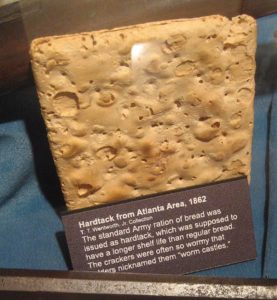
Traditional hardtack keeps indefinitely if kept dry.
The oldest piece of hardtack in existence is in a museum in Florida and was baked in 1851! There are other specimens from the Civil War.
They are still edible to this day!
What other food could you say that about?
Hardtack is cooked until very dry and hard. Moisture is nonexistent in properly made hardtack.
History of Hardtack
Unleavened breads have been survival food for millennia. Archaeologists have found 6,000-year-old pieces of unleavened bread.
Yeast was not used for bread until the age of the Egyptians, so if you were eating grains, they were either cooked in dishes or made into unleavened cakes. This was an excellent way to put back for hard times such as crop failures.
Unleavened breads were brought over the ocean by intrepid explorers and used on expeditions.
In some ways, the settlement of Europeans in the future United States was primarily fueled by hardtack, which made it possible to travel and explore with some level of food security.
During the Civil War, hardtack was a standard ration for soldiers. Many songs during the war contained lyrics about this staple food that kept troops fed and moving under some of the harshest circumstances.
Supplies Needed
The beauty of hardtack is that you need very little to make it, and you can make as big a batch as your oven will hold.
Here are the supplies needed besides ingredients.
1. Mixing bowl – metal, glass, ceramic, anything will do.
2. Dough Docker or something to put holes in your dough. If you don’t have a dough docker and plan on making lots of bread, I recommend getting one. They last forever.
3. Cookie sheet or wire pizza sheet. I like mesh pizza sheets because they provide good airflow to dry the hardtack quicker and more evenly. I always use them for pizza, crackers, and other baked goods that I want to get nice and crispy.
Buy Supplies Online
Recipes
Print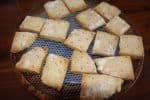
Modern Hardtack Recipe
- Total Time: 1 hour
- Yield: 3410 calories 1x
Description
Is this the ultimate survival food? Before granola bars, massive amounts of preservatives, and fancy packaging, there was hardtack.
Ingredients
- 3 cups White Flour
- 1.5 cups Sweet Sorghum Flour
- 9 Rounded Tbsp Nutritional Yeast
- ½ Cup Refined Coconut Oil
- 3 Tbsp Iodized Salt
- 1.5 cups of water
Instructions
- Preheat your oven to 375°F
- Add dry ingredients to your bowl.
- The amount of water you need can vary a bit. I add a ½ cup at a time and work it in.
- Knead dough, The end consistency you are going for is just pliable enough to be smooth and worked with a rolling pin.
- Roll out till approx 1 inch thick
- Cut into square biscuit shapes
- Dock or poke holes in the dough.
- Bake in the oven for 30 to 40 mins
- Allow to cool completely
Notes
Traditional Recipe Used By The Pioneers (instructions are identical to modern recipe)
4.5 cups White Flour
3 Tbsp Salt
1.5 cups of water
- Prep Time: 20 minutes
- Cook Time: 35 minutes
- Category: Snack
- Method: Baked
- Cuisine: American
Nutrition
- Calories: 3410
- Fat: 127g
- Protein: 64g
The Method
I will now show you how to make hardtack; the following method is the same regardless of your recipe.
1. Add dry ingredients to your bowl.
2. The amount of water you need can vary a bit. I add a ½ cup at a time and work it in.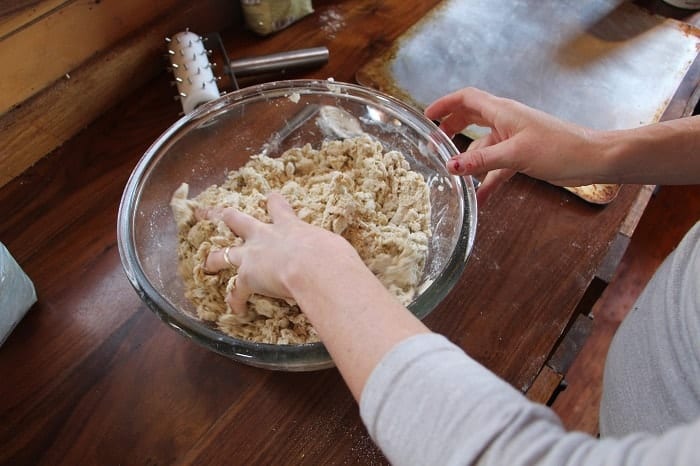
3. The end consistency you are going for is pliable enough to be smooth and worked with a rolling pin. The goal at the end of baking time is to have zero moisture. Knead as much as needed.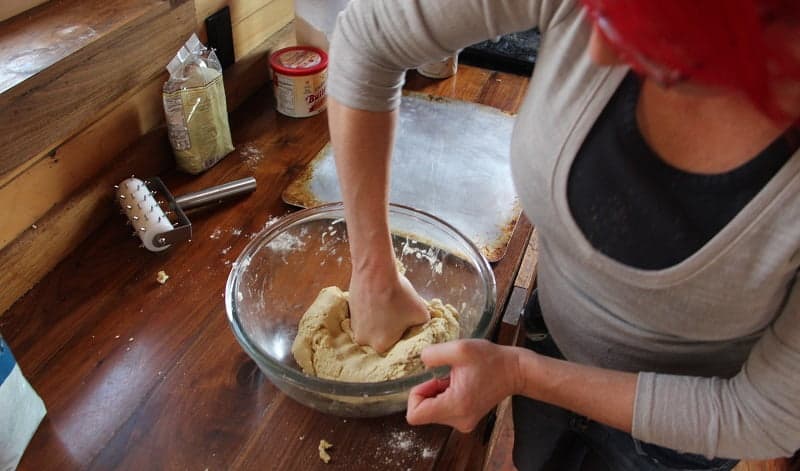
4. Docking is important because the holes allow steam to escape and your finished product to dry out completely. You can just poke holes in the dough if you don’t have a bread docker.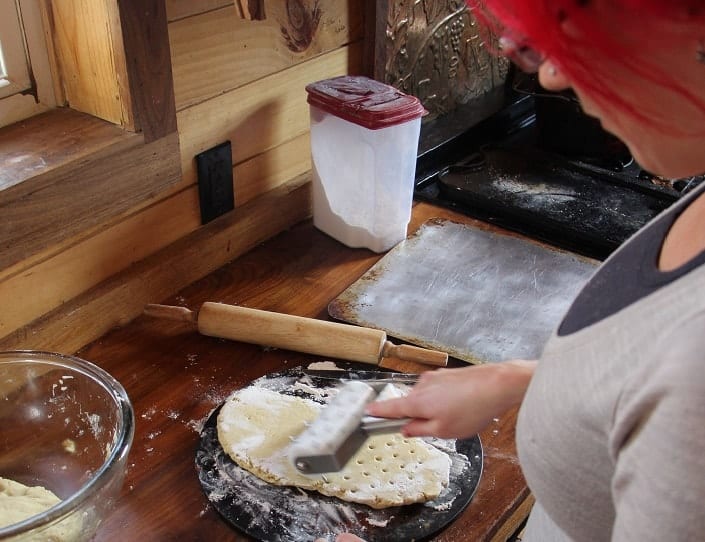
5. The size of the squares of hardtack you make is entirely up to you.
Smaller squares will dry out faster. You can try to cut your squares out to be close in size. It does not have to be exact, and there is no set shape they have to be.
A lot of people choose square or round, like a biscuit. I wanted to experiment and see how much difference it made, so I varied the size a little.
I found that varying the sizes and even the shape slightly made no significant difference in getting them rock solid.
6. Bake in a preheated oven at 375°F for between 30 and 40 minutes.
7. The hardtack should be slightly golden brown when done.
8. Leave crackers to cool and allow any residual moisture to evaporate.
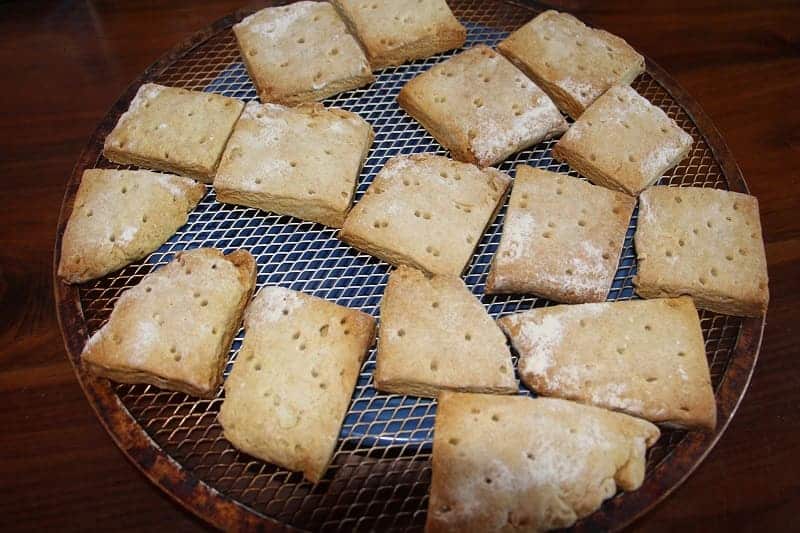
What extras can I add to hardtack?
Some dried products can be added to the flour, water, and salt mixture.
If lactose intolerant, you can use dried buttermilk powder for added flavor and nutrition. Sugar can be added for sweetness. Some hardtack recipes recommend brown sugar because it adds flavor and sweetness.
Oils that are highly refined and have long shelf life can be added.
Recommended Reading: Ultimate Guide To Food Preservation
Other things include cocoa or carob powder for flavor. Yes, you can have chocolate hardtack if you want it! (Read more about storing cocoa powder.)
Please note that adding ingredients beyond the ordinary flour, salt, and water can affect shelf life, but if you are vacuum sealing, this can be pretty minuscule. (More on this later).
Just remember not to use animal fats like lard or tallow because they are more likely to go rancid.
How To Eat
Hardtack was meant to be eaten with some type of liquid. If you have not tried to eat any, you need to realize that they are not kidding when they call it hard.
In the past, people put it in their jaws and let their saliva soften it until they could swallow. However, it is better when it can be soaked in milk, broth, soup, or whatever liquid you have to hand.
This is a food that you can hurt your teeth or mouth with if you don’t take care when eating it. Beverage or broth is your friend in the world of hardtack.
Nutritional Profiles
I did the math, and these nutritional profiles are close to what you can expect from my recipe and the traditional one. I just used the existing dietary labels on the products I used and did the math based on my measurements.
| Recipe | Calories | Fat | Protein |
|---|---|---|---|
| Modern Hardtack | 3410 | 127 grams | 99 grams |
| Traditional Hardtack | 2160 | 9 grams | 64 grams |
Salt: Don’t Underestimate Its Value in a Survival Situation
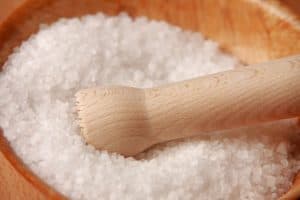
The amount of salt you use can vary based on your taste.
Remember that salt can be a lot harder to get in a survival situation than you would ever imagine.
While many of us try to watch our salt intake, you might want to increase it during hard times.
Think about it like this; when you sweat, you lose salt, and during hard times, you might have to do more physical labor and rely on more energy-intensive methods for transporting yourself and gear. Walking, pulling wagons, carrying items rather than using a vehicle, etc., will result in you sweating out salt at a higher rate than before.
Salt was often left out of hardtack in the Civil War because it was paired with high-salt foods like salt pork when possible. Cured pork belly and coffee were often paired with hardtack if times were in favor of the soldiers.
Later in the war, soldiers felt lucky if they just had some hardtack to gnaw on.
The Amount Of Protein You Need Depends On Age and Gender
According to Web MD, an adult woman needs 46 grams of protein per day while a man needs 56 grams.
Pregnant or breastfeeding women should try for 71 grams. The protein level of your hardtack can easily be adjusted by adding more nutritional yeast.
Note: The level of exertion required during hard times and the increased calories required for pregnancy or breastfeeding mean that you would need to eat more.
Nutritional Yeast Adds Folic Acid
Women that are pregnant or of childbearing age should be concerned about folic acid. The hardtack recipe I created means that if one consumes 1,705 calories of hardtack or half the recipe, they will get 350% of the recommended daily value of folic acid.
Other Vitamins & Minerals
It is vital to maintain a good intake of essential vitamins and minerals. You will come through any survival situation better with vitamins and minerals.
Keeping your immune system functioning at as high a level as possible is critical when medical services may be hard to procure.
Multivitamins are great, but I see no harm in adding some nutritional yeast to unleavened bread. It is not going to raise the bread. You are mixing hardtack dough and baking immediately, so even if it did cause it to rise, it wouldn’t happen that quickly.
Nutritional yeast also adds a cheese-like flavor without using any dairy products, so it is great for those that want to avoid that.
Limiting Nutritional Factor: Vitamin C
One ingredient that I would consider adding to hardtack is Vitamin C. While hardtack contains good levels of B-Vitamins, it completely lacks Vitamin C.
These are the two vitamin deficiencies that will cause problems soonest during a survival situation.
Scurvy was a common problem years ago but don’t think it could not happen again. Make sure you have at least some vitamin C powder or capsules put back.
This could be as simple as adding a capsule of Vitamin C to the pouch before you vacuum seal your hardtack.
You could also use a packet of Emergen C drink mix. Simply put this in with your hardtack ration, and you will have something to flavor your water and help get the hardtack to an edible consistency.
Storage Of Hardtack
The most important things to remember when it comes to storing hardtack:
- Keep it moisture-free
- Protect from insects, rodents, and other pests
Since we live in the wonderful age of vacuum sealers and inexpensive storage containers, I suggest that you vacuum seal it with an oxygen absorber after your hardtack is cooled off and set up solid. Store it in a plastic tote with a tight lid, and it will stay good indefinitely.
During the Civil War, hardtack was commonly infested with weevils and sometimes became wormy.
This is because although it kept well, soldiers did not have good storage. Crates of hardtack were exposed to moisture and insects quite often.
During that terrible war, they often ate it anyway because that was all they had.
How much hardtack should I put back?
If you are on a budget, then knowing how to make hardtack is an excellent way to create a cheap stash of food for you and your family.
There is something to be said for putting back far more than you need because this will allow you to have some inexpensive extra food to trade and have some on hand in case you get people showing up at your door asking for help.
Commercial Hardtack
There are very few producers of hardtack in the United States, but you can also get something called Pilot Crackers, basically the same thing. It is not cheap to buy either of these, so making your own will offer better nutrition at a lower cost.
Authentic hardtack goes for a good price due to its popularity with reenactors and the lack of commercial producers.
Do you have any hardtack recipes, stories, or tips? Leave them in the comments below.
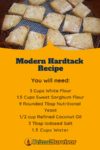







I amde some for my daughter. I will give it to her for Christmas. She is a huge soup eater and loves adding crackers to her food.
I am going to add timothy hay pellets to mine with lemon juice instead of water to make something for my guinea pigs. Does not have to last for months for them
If your hardtack goes rancid because of added fats, I would think that should be easy enough to detect. Moldy hardtack due to moisture and nasty bugs/worms are also easy to find. What other ways can hardtack “go bad”? How would one know?
My comment is about all the great suggestions of adding things like, honey, dried fruit powders, vitamin C or nettles. Because Hard Tack is generally considered in these times as a last resort survival food it is better to make it as it was originally. You store your honey, dried powders and Vitamin C separately, adding them later for flavour. Foraging for fresh nettles is better than adding to the recipe.
Yachties kill weevils in flour (and probably other dry goods) by popping it in their freezer until ready to use. Any land-lubbers tried that approach?
Three to seven days in the freezer should kill insects and eggs. We talk about that here: https://www.primalsurvivor.net/bugs-weevils-moths-food-storage/
I personally find freezing a pain to do for long-term food storage, so just store my food with O2 absorbers.
Can you run the hardtack thru a freeze drier instead of cooking?
Freeze drying doesn’t cook the food. So, you’d have to cook the hardtack AFTER freeze drying (and before eating) it to make sure it was safe to eat.
I’m still looking for hard tack being sold on line. I want it made with a200 year old recipe. I want to see if it can be used as a substitute for Single aught buckshot.
It’s called pilot bread. It’s the same thing as hard tack just made for long term storage for pilots.
I plan to make this soon. I will start with the traditional recipe and then try the modern. I am thinking that moringa powder might be a good additive? So many health benefits and very high in C.
Moringa powder is great — but I personally wouldn’t add it to this recipe because it is baked. Heat destroys a lot of vitamins. Since Moringa is so expensive, I only use it raw foods (in things like DIY energy bars or smoothies). However, I do like adding cheaper greens to recipes. For example, I dehydrate radish tops and then blend them into a powder. The powder then goes into bread dough/baked goods. The vitamins might die in the heat but the minerals like iron survive high temps.
I wouldn’t be so quick to add Vit Cto a survival food. I had some old Kool-
Aid once that I stirred up–that’s how I discovered old Vit C is a diharretic. Not exactly something you want in a food that might not get eaten for years.
Dehydrated/dried stinging nettle ground to a power would add protein and Vit C.
Vitamin C oxidizes really quickly but iron doesn’t. And stinging nettles are loaded with iron! 🙂 I add all sorts of homemade green powders to food. My favorite though is hogweed (Heracleum sphondylium).
A stick of peppermint gum is great for keeping weevil away. I remember we had weevil in flour when I was a kid. My mom complained about it to a friend and she told us to put a stick of peppermint gum in the flour container. Problem solved.
I imagine it would work in a container of hardtack.
Delicious!!! I added some sugar and it tasted really well. Ok, so I have a question. I have rice-based protein powder. Will that change the shelf life or make the hardtack not cook? I am asking this because it is one of the only proteins that I and my kids can eat because we have a ton of severe food allergies. If you can get back quickly thank you so much!!!
Not 100% sure of that, but rice protein should be okay. Proteins don’t go rancid like fats do.
I’m looking for a way to make the Hardtack tastier without decreasing the amazing shelf life. I’ve heard Bouillon Cubes can be stored for an indefinite time due to the high salt content. Can crushed Bouillon Cubes be used to substitute the salt?
Most Bouillon cubes are made with Monosodium Glutamate (MSG). Not exactly healthy or natural but MSG makes everything taste better! You could definitely use it instead of salt.
Hardtack was made originally with “entire wheat” now known as whole wheat which is not what is sold as such by most stores or used by bakeries today. Ground fresh it is High in various vitamins and minerals with the germ and bran intact. If properly made, baked and stored hard tack did last for a long time. White flour is bleached and has synthetic vitamins and iron powder added to prevent malnutrition based diseases that occurred when it was first introduced at the Chicago World’s Fair in Chicago in 1893 and became popular because it was so troublesome to take whole grains to the local water driven mill weekly to have them ground. Get educated about using a modern electric grain mill to make your breads tasty plus truly nutritious and avoid celiac disease or other bowel problems by visiting Bread Beckers Inc. Sue’s recipes are phenomenal and our family credits her for our excellent health since 1996. Use her original Dr. Graham’s Cracker recipe made with Hard Red Winter Wheat and you will never buy another commercially baked graham cracker again. Bon Appetit
Personally, if seriously prepping, I’d use a manual mill and store the whole berries in Mylar with O2 packs and grind when needed. Those have a long shelf life.
Honey is a forever food. Can you add honey to hardtack recipe for a change in flavor. Also…I toast my flour in a 350 oven before baking hardtack. This kills any vermin and gives off a nutty aroma which adds to the flavor. I also thought about finely ground rosemary for another flavor.
You can add honey, sugar, maple syrup… If you add too much though, it might mess up the texture. However, the recipe is pretty flexible. I would just do a small batch to make sure it comes out alright instead of experimenting with large batches. *I should add that I’m the type of person who never uses recipes and just eyeballs everything I make!
How much brown sugar can I add to a batch and shelf life if I vacuum seal it? Thanks
About 1/8 cup of sugar per cup of flour is a good starting point. The recipe is pretty flexible so you can adjust it without messing it up (though too much sugar would probably make the hardtack fall apart/crumble). Vacuum sealing will help increase shelf life but I can’t give an exact shelf life: it can last years or only months. The key is to keep it DRY.
Being cranberry season just now, what is the possibility of incorporating dried ground cranberry in the hardtack? This would provide an iota of v C. Or dried ground or zested citrus skins? And how will the dried buttermilk powder behave in this recipe? Early rancidity or not? Beginning to sound good now especially with the rosemary or some thyme…
Cranberry shouldn’t affect shelf life too much — so long as you keep the hardtack dry AND (important!) make sure insects can’t get to it. Those annoying pantry moths love dry fruit! Buttermilk will make the shelf life shorter but, if you can keep it very cool, it will still last a very, very long time.
Hi there; thank you for this article
Just have one question please?
Can I put dried rosemary or any other herb(s) in the mixture?
I don’t see why not. 🙂 So long as they are dry, they should be fine in the mixture.
I have trouble digesting gluten. May I substitute corn meal successfully?
I might try rice flour with a bit of cornstarch instead (or a gluten-free flour mix). Corn meal will also likely work (haven’t tried it) but it might go bad faster.
Docked cornmeal has been sifted to remove the bran so it may have a longer shelf life. If gluten intolerant try using white rice and tapioca flours. Rice has fed generations for millennia.
HI, Great info here. Practicing several recipes now. I found a suggestion to put in jars with white rice as moisture absorbtion. Will try to let you know if this works.
Friends, just a little reminder that vitamin C is sensitive to heat. It might be wise to store some alongside the hardtack without baking it. I’m eager to give a try of the alternative flours in making this, as three of us in my family can’t consume wheat.
Vitamin C is also really sensitive to oxygen. I’ve basically come to accept that I won’t be getting vitamin C from any of my stored foods (though hopefully not all the nutrients in my multivitamins will die). Luckily foraged greens are loaded with it vitamin C and other nutrients 🙂
Save your orange peel skins dehydrate them then turn them into a powder. Boom vitamin C power packed.
During the civil war; soldiers usually found weevils in their hardtack. They did not mind them being there. The bugs added PROTEIN to the hardtack.
Where can you buy hardtack now a days? Why would anyone want to willingly eat it?
Well, Civil War re-enactors use it, and I think there’s even a commercial manufacturer that supplies them. And our library had a “Titanic Tea” a few weeks ago, they included hard tack (along with spring pea soup, miner’s casserole, and voul au vents). I found in intriguing and surprisingly chewy once you got them started. Obviously, its most popular use is among people who want to be able to create their own long-shelf-life foods; hard tack is probably the “gateway recipe” to making your own survival food.
I look forward to trying both recipes and keeping a few pounds min of this always made and ready!
To help with consumption and health if only the early settlers of our country only knew what we know now! Vitamin C is very plentiful in North America and you want something wet and warm to help soften and comfort you as well! Make pine needle tea, collect needles from a pine tree while boiling some water, one you have the needle and clean them up add about 1/2 cup to 3 cups of water, simmer ( never boil with needles in water) to make a mild tea loaded with Vit C and a source to dip and soften your bicuit!
Yes! Good comment about pine need tea. I actually don’t like it warm but love it as a cold drink with some lemon and honey.
A diabetic cannot eat this version of the recipe due to the high carb content. What do you suggest as a substitute? Would almond flour and flax seed take the place of the flour and sorghum flour? Any nutritionist take that into account?
Sorry we have not tried a low carb version so cannot comment. If you do try this please report back as would be interested in how it turned out.
Those flours would probably work but, because of the high amount of natural oils in nut and seeds, the resulting hardtack wouldn’t last nearly as long. *I dehydrate beans and blend them into a powder to make a bean flour (which I add to bread dough or rehydrate to spread on tortillas, etc.). Now I’m wondering if this bean flour could work for low-carb, long-lasting foods. If I get around to trying it, I’ll let you know. 🙂
What about using wheat, buckwheat coconut flour etc? How about using honey in place of sorghum as honey never goes bad? And will the coconut oil eventually go rancid? Thank you
Don’t see a problem with using alternative flours but cannot confirm for sure as have never tested it. Let us know if you try.
what difference with Anzac Biscuits
<>
Google:
How long do Anzac biscuits last?
2 weeks
To make chewy Anzac Biscuits, reduce the baking time to 15 minutes, swapping the trays around after 8 minutes. These biscuits will keep in an airtight container at room temperature for up to 2 weeks (if they last that long!)
The article states that you should package the hardback with a moisture absorber. I assume that this is different than an oxygen absorber. Where would I find them? Looking forward to trying the original recipe and also some variations.
No it is the same thing. We have an in-depth section about oxygen absorbers. in our mylar bags post. Let us know how you get on with the recipe, a picture would be great!
I think Dawn was asking if moisture absorber’s and oxygen absorbers are the same thing, and the answer is no. Moisture absorber’s are generally made from silica gel a porous sand. You find them in pill bottles, clothing, purses, electronic equipment. Silica gel inhibits moisture, it therefore prevents mold to grow.
Oxygen absorber’s are tiny packs that contain iron filings, salt and clay. The clay provides moisture, and works with the salt to activate the iron filings. The process starts as soon as the oxygen absorber packet is exposed to oxygen.
Can oxygen absorbers and moisture absorbs be used together? The answer is NO. Because the oxygen absorber needs a little moisture to start the oxidizing process absorbing oxygen and releasing nitrogen.
Just wondering. If you roll out the dough very thin, like maybe 1/8-1/4” thick, would it not be so hard to eat? Would it be more like a cracker? Would it store ok?
This will store OK just watch the cooking times as it will cook quicker. I imagine it will be slightly easier to eat but would be interested in your findings if you try this.
You said adding more to the recipe would shorten the shelf life, what about other dry ingredients? For example what if you add a tbsp of Mrs dash to the mix. It would add flavor but how bad would it throw off the shelf life?
What is the corresponding serving size for those nutrition facts?
Will totally depend on the size of biscuit you prepare. If you make the recipe here you should be able to work out approximately how many calories per biscuit you have and plan your ration accordingly.
Just tried this out, worked a treat!
Tried out the modern version and it worked well. Thanks!
I have celiac disease. Can a gluten free flour be substituted successfully?
Shouldn’t be an issue, just make sure it is bone dry before storing.
A Question not a comment, Can protein powders be add to the hard tack recipe and if so do you just add it of remove some flour?
Protein powders could be used but I would say that if they contain any dairy or animal proteins it could alter how long the hardtack would keep depending on the level used. Plant based proteins shouldn’t change how long it would stay good.
Hi, I was wondering why you were specific about using iodized salt? We’re on the West Coast & have access to all kinds of great local sea salts. Is there anything beneficial about using the iodized over sea salt?
I specified iodized salt because it prevents iodine deficiency and thyroid problems related to that. I love cooking with high quality salts too but iodine levels are really important to maintain and during a survival situation, iodine might be a bit harder to come by. Sea salt is not rich in iodine unfortunately. It does contain some but it might make it hard to get the levels needed. The modern diet and multi vitamins means that iodine deficiency is generally not something to worry about during good times. I do know that Morton and other salt manufactuerers do sell sea salt that has been fortified with extra iodine so that might be a good middle ground. Thanks for reading and a great question!
mine is more of a question? can i use a dehydrater to dry my hardtack in sted of the oven?
Yes you can use a dehydrator but one that has forced air and reaches a temperature suitable for making jerky is recommended for best results. The Nesco Snackmaster is what I use. I cannot tell you how long it will take to do it in a dehydrator for sure since that depends on what temp you can set it to and how wet your mixture is. As long as you get it bone dry, you should be good to go!
Great question Barbara, we have a post about dehydrators here if you want to do some more research. (the Nesco snackmaster scores well!) https://www.primalsurvivor.net/best-food-dehydrators/
Moisture absorbers are called dessicant. They sell them on Amazon and aren’t very expensive at all.
True enough, but don’t confuse oxygen absorbers with moisture absorbers. They are different and serve two separate functions. Both are available on Amazon.
When storing your hardtack , add approx 1tsp (1TBSP) food grade diatemouces earth to container this will help with reducing moister & help elimanate any possible infestion of weevils or other grain bugs, and it is edible and good for your… google it…it can be used in other storage uses also.
Excellent suggestion Bob! I use DE for a lot of things around the farm. Thanks for reading and contributing to Primal Survivor.
Hi,
Can you go over the reasons you added the Nutritional yeast to the recipe?
Was is structural or flavoring or needed for a specific purpose?
Thank you
Steve
Hi Steve – it is mentioned in the article but we added it as a source of folic acid. Standard yeast can be used in its place.